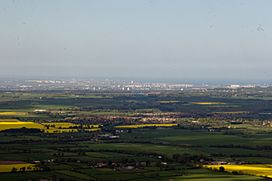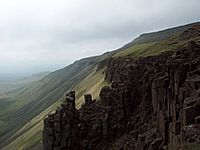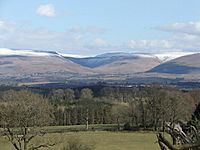Teesdale facts for kids
Quick facts for kids Teesdale |
|
|---|---|
| Tees Valley, Teesside & Cleveland | |

Lower Teesdale (Teesside) from Carlton Bank
|
|
| Geography | |
| Location | south of County Durham and north of North Yorkshire, England |
| Country | England |
| Population centers | Barnard Castle, Tees Valley towns, Great Ayton & Stokesley |
| Borders on | |
| Traversed by | A66 road, Teesdale Way, Tees Valley Line |
| River | Tees, Skerne & Leven |
Teesdale is a beautiful valley in Northern England. It gets its name from the River Tees, which flows through it. Most of the water in this area either starts in or flows into the River Tees. Other rivers like the Skerne and Leven also join it.
The upper part of Teesdale is often just called Teesdale. It sits between the Durham Dales and Yorkshire Dales. A large part of Upper Teesdale is in the North Pennines AONB. This is a special protected area known for its amazing scenery. It's the second largest AONB in England and Wales.
The River Tees begins high up near Cross Fell. This is the tallest hill in the Pennines, standing at about 893 meters (2,930 feet). The weather here can be very cold, almost like the Arctic. Sometimes, snow stays on Cross Fell even into June! There's even a ski area called Yad Moss.
The eastern part of Teesdale has both busy towns and quiet countryside. This area includes places like Tees Valley (also known as Teesside) and Cleveland. Roseberry Topping is a famous hill in the southeast. This hill and others nearby are the northern edge of the North York Moors.
Over time, different parts of the valley have become known by new names. This is because these names are used for political areas and local governments.
Contents
Geology of Teesdale
Teesdale has some interesting rocks that are not common in the Pennines. About 295 million years ago, hot, melted rock called magma pushed its way up. It spread through cracks and layers of older rock, which was mostly Carboniferous Limestone. This melted rock then cooled down slowly, forming a hard rock called the Whin Sill.
As the Whin Sill cooled, it shrank and cracked into tall, vertical columns. The heat from the magma also changed the limestone above it. This turned the limestone into a crumbly rock known as Sugar Limestone.
In the past, soft rocks called shales were dug up here. They were used to make slate pencils.
More recently, Ice Ages shaped the valley. Huge glaciers moved through, carving out the land. Much of the old river path is now buried under layers of dirt and rocks left behind by the glaciers.
Plants and Wildlife in Teesdale
The hard rock of the Whin Sill, with thin soil on top, stops many trees from growing. This helped some special plants that survived the Ice Age to stay here. These plants are usually found in Arctic or high mountain areas. The Sugar Limestone also provides the right conditions for some of these plants.
Teesdale is famous among nature lovers for its "Teesdale Assemblage" of plants. This means you can find different plants growing together here that are usually found far apart in other places, both in the British Isles and abroad.
A part of Upper Teesdale near the Cow Green Reservoir is a National Nature Reserve. It's home to the rare Teesdale Violet and the beautiful blue Spring Gentian. You can also find common Pennine flowers like rockrose, spring sandwort, mountain pansy, bird's-eye primrose, and butterwort.
Hay meadows in the valley, especially above High Force, are carefully looked after. They have many different flowering plants, including globe flower, wood cranesbill, and Early Purple Orchid. On the south side of the River Tees near High Force, you can see the largest remaining juniper wood in England.
Geography and History of Teesdale
The famous waterfalls of High Force and Low Force tumble over ledges of the Whin Sill. The powerful Cauldron Snout is also found here. The River Tees then flows past Barnard Castle and Startforth. It continues south of Darlington, through the borough of Stockton-on-Tees, and north of Middlesbrough. Finally, it reaches the North Sea between Hartlepool and Redcar & Cleveland.
The River Skerne flows through Darlington. The River Leven starts near Yarm and Ingleby Barwick in the borough of Stockton-on-Tees. It then flows through Stokesley and Great Ayton in the Hambleton District.
The main town in West Teesdale is Barnard Castle. It's a historic market town famous for the Bowes Museum. Other places include the small town of Middleton-in-Teesdale and villages like Mickleton, Eggleston, Romaldkirk, and Cotherstone. Middleton used to be a center for lead mining. You can still see signs of this industry on the hillsides. On the south side of Teesdale is Kirkcarrion, an ancient burial site from the Bronze Age.
East Teesdale is the area where the River Tees flows through flatter land, from west of Darlington to the Teesmouth. This area is also known as Tees Valley. Middlesbrough is the largest town in the whole valley.
Teesdale runs roughly next to other valleys. To the north is Weardale (which includes Bishop Auckland and Sunderland). To the south is Swaledale (with Richmond). To the west are the Yorkshire Dales, and to the east are the Cleveland Hills and North York Moors.
Teesdale gave its name to the former Teesdale district in County Durham. However, the southern part of Teesdale was historically part of the North Riding of Yorkshire. In 1974, it became part of County Durham for administrative reasons. All of West Teesdale is now part of the Bishop Auckland parliamentary area.
Teesdale in Local Culture
Teesdale is important to the local area and has given its name to several things:
- Teesdale (district), a former local government area in County Durham.
- Teesdale Allotments, a special scientific site.
- Teesdale Mercury, a local newspaper.
- Middleton-in-Teesdale, a town in the valley.
- Forest-in-Teesdale, a village.
- Teesdale School, a school in Barnard Castle.
- Teesdale Way, a long walking path that follows the River Tees.
- Teesdale Iron Works, the old name for a large industrial company called Head Wrightson.
- Teesdale Business Park, built on the site of the old iron works.
- Teesdale Park, the home ground for Thornaby FC football club.
See also
 In Spanish: Teesdale para niños
In Spanish: Teesdale para niños




